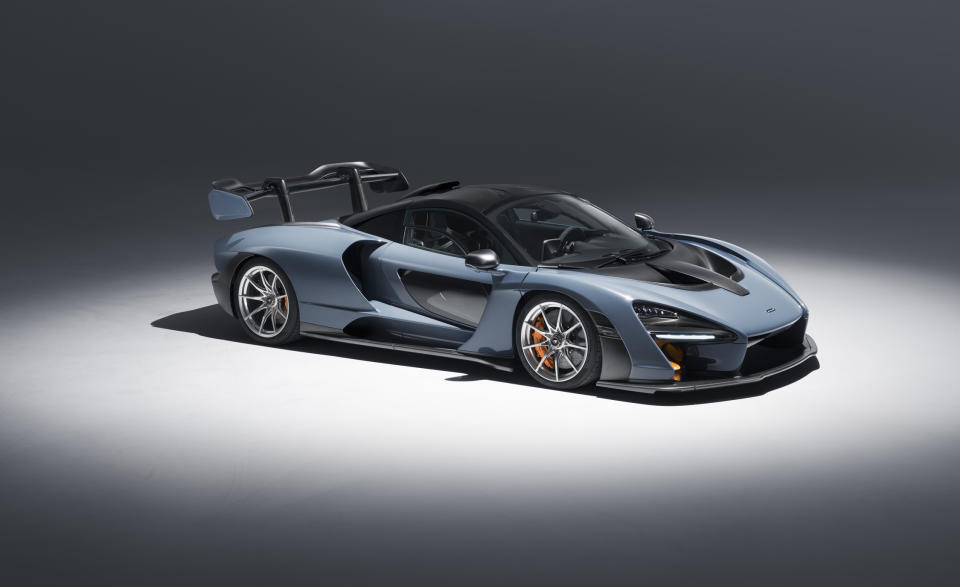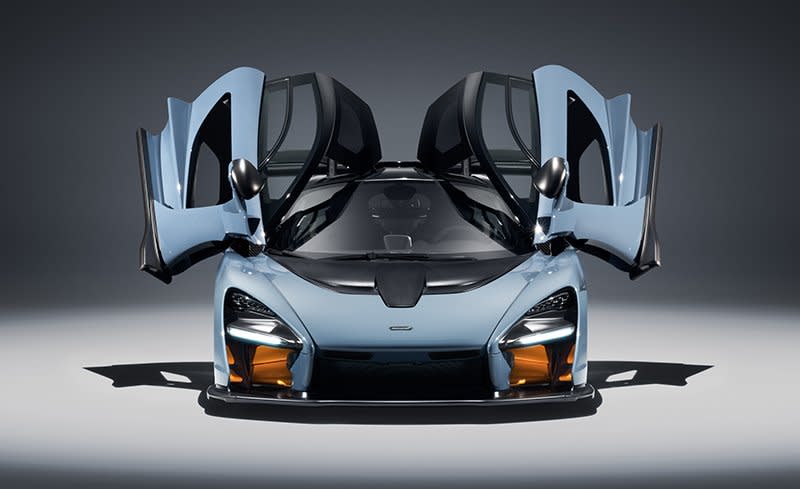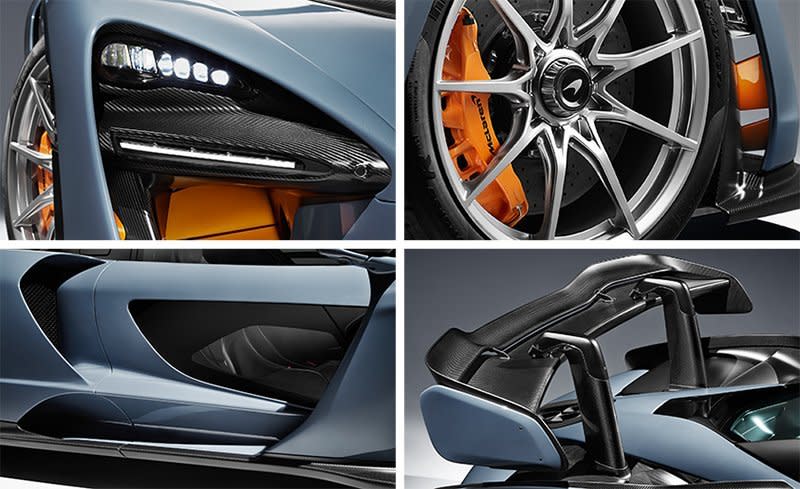More McLaren Senna Info Spills Forth: Here's What You Need to Know

Naming a car for arguably the best driver ever to grid a Formula 1 race is a bold decision, and McLaren calling its new track-focused hypercar the Senna is akin to Ferrari debuting the Schumacher or Audi launching a 300-mph Rosemeyer. This is hallowed ground. Getting it right in the eyes of racing fans, the company’s customers, and Senna’s family—who approved use of the name through the Aryton Senna Foundation—is much harder than getting it wrong. Later this year, once we drive the Senna, we will confirm whether the British supercar maker has achieved its goal of producing the “lightest, fastest, and most engaging McLaren yet.” Until then, and on the heels of the first wave of information released in December, here are 10 things we gleaned from a recent trip to poke and prod both the car and the minds of its engineers. It looks quite promising.
This Is a Purpose-Built Track Car
It has a license plate and airbags, sure, but don’t be confused by these concessions to road legality; the Senna is built to turn fast laps on road courses. McLaren’s internal development matrix that pits roadworthiness against trackworthiness puts the Senna as far to the track side as it can go and still be streetable. Both the hybrid P1 and the “everyday” 720S are smack in the middle. If McLaren is going to make a more track-ready road car, it will have to change its own scale. An upcoming three-seat model code-named BP23 is at the opposite end of the scale; it will focus on on-road comfort.

The Upside of Downforce
Key to the Senna’s race-ready looks and performance are its aerodynamics. At 155 mph, the active rear wing and splitter combine with active elements in the nose (highlighted in a contrasting color) to generate 1764 pounds of downforce. That’s more than the astronomical numbers put down by the P1. And that is achieved nowhere near the vehicle’s top speed. Downforce increases with the square of speed; speed also increases drag. To reach its maximum velocity of 211 mph, the Senna’s rear wing trims its attitude. McLaren won’t yet disclose downforce above 155 mph, and we’re guessing that’s because the number is quite, uh, heavy.
It’s Has Split Windows, But Not Like Any Vette’s
The half-drop side windows serve three purposes. First, they’re a nod to the F1, the car that introduced the world to McLaren’s supercar-development prowess in the 1990s. Second, they reduce drag. Every window seam is a trip edge that catches air, so if you can limit the linear feet of seams, say from 10 feet to four feet, the drag coefficient will drop. Third, they save weight and space. By limiting the height of the curved glass that moves—the greenhouse shape necessitates aggressively curved side windows—the motors and hardware can be smaller and the doors can be thinner. Undressed, the Senna’s doors weigh 22 pounds, compared to the 42-pound units in the 720S.

It Has a Next-Level Suspension
Like the P1 before, the Senna relies on a hydro-pneumatic damper package that links the dampers both transversely and longitudinally. This system gave the P1 a docile demeanor on the street while maintaining razor-sharp precision on a track. When put in Race mode, the Senna drops its already low nose a further 1.2 inches and its rear by 0.9 inch. This rake improves the diffuser’s performance and offers little ground clearance. The front is so low that McLaren fitted a sacrificial section to the splitter that is easily swapped out using exposed fasteners.
The Rear Wing Is Top-Mounted
The so-called swan-neck mounts are ripped right from the world of racing. By keeping the bottom edge of the airfoil free of mounting pylons, the wing’s business edge can maximize its ability to push the Senna onto tarmac. Under braking, the wing snaps upright to act as an air brake. The rear wing weighs just 11 pounds.
It Uses Aero Tech Outlawed by Formula 1
Formula 1 banned double diffusers for the 2011 race season, but that doesn’t mean McLaren can’t put them on road cars. Diffusers can generate as much or more downforce as wings. As are most such pieces on high-end supercars, the diffuser is made of lightweight, strong, and stiff carbon-fiber-reinforced plastic. Of course, so is most of the rest of the car. From the central tub, to the one-pound front fenders, to the seven-pound seats, it’s all carbon fiber. McLaren has put all its chips on the black weave, so much that it just christened a new carbon-fiber factory in Sheffield, England. While the Senna’s tubs will come from Austrian supplier Carbo Tech, the three-seat BP23 tubs will serve as Sheffield’s pilot build. After the 106 planned BP23 tubs are off the assembly line, we suspect the tubs for McLaren’s next-gen Sport Series (the part of the lineup that currently includes the 570S and 570GT) models will be the next batch to bake in Sheffield’s autoclaves.

Auxiliary Windows
The glass panels in the lower doors and the roof are purely there to make the cabin feel airier. Seeing the road rush by out of the corner of your eye increases the sensation of speed, as when riding a motorcycle, too. But don’t believe anyone who says the knee-height windows are to improve corner visibility, as anyone using them to spot apexes will promptly become an internet sensation. The lower door side, roof, and rear portions use Gorilla Glass, as do most smartphones, but if one wants you can order the car with carbon-fiber inserts instead. If we were lucky enough to spec a Senna of our own, the only glass we would opt for is in the rear, just so we can catch a glimpse of the engine every now and again.
Updates for theM840TR
McLaren’s twin-turbo 4.0-liter V-8, named M840TR here, gets a rework for duty in the Senna, where it makes 789 horsepower. To get to that output level, engineers swapped in new camshafts, redesigned the intake and plenum (now with a roof intake), and fitted two high-flow fuel pumps. The intake plenum also is made of carbon fiber and, at six pounds, weighs about half as much as the cast unit in the 720S. Compared to the 710-hp engine in the 720S, the Senna’s V-8 churns up its greater power at 7250 rpm, 250 rpm lower, and produces 22 additional pound-feet of torque (590 lb-ft at 5500 rpm) with a pair of low-inertia twin-scroll turbos. As much as 516 lb-ft is on tap at 3000 rpm. The engine will be tasked with moving what we expect is a 2850-pound car when loaded with fluids. We may never have the opportunity to confirm McLaren’s performance claims from this extra-limited hypercar—zero-to-60 mph in 2.7 seconds and a quarter-mile pass of 9.9 seconds—but we have typically bested McLaren’s estimates by a tenth or two when we’ve tested their models in the past.

There Is a Wee Bit of Steel in There
McLaren sweated the details in order to reduce mass as much as possible. Of the eight control arms on the car, only two—the front lower units—are steel. The rest are forged aluminum. Woking also swapped out 6mm fasteners for smaller, 5mm fasteners in some cases, while redesigning the bolt heads in others, for a 33-percent mass savings. The exhaust is made of exotic Inconel and slightly less-exotic titanium. Also, it is worth noting that the audio system weighs just 16 pounds.
To the 24 It Will Go
McLaren isn’t a company to build a low-volume car without purpose. The F1 was a game-changer meant to show the firm’s might. The P1 was a proof-of-concept that hybrids have a place in the future of sports cars. And while it will not officially confirm it, all signs point to McLaren returning to the 24 Hours of Le Mans with the Senna. Given the speed of today’s prototype racers, there is little chance that a Senna GT3 car could repeat history and take an overall title, as the F1 did in 1995, but McLaren has its sights set on following in the reborn Ford GT’s tire tracks with a victory in the GTE Pro class. There, it will face off against the Ford, a couple of Chevrolet Corvettes (potentially of the mid-engined variety), Ferraris, and Aston Martins.

 Yahoo Autos
Yahoo Autos 